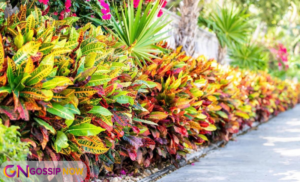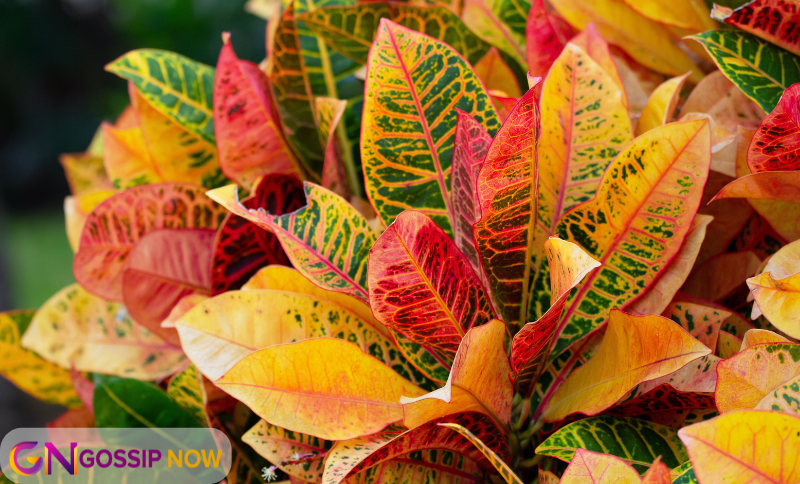Croton plants (Codiaeum variegatum) are known for their bold, colorful leaves and unique patterns. While they make stunning indoor and outdoor plants, they require specific care to maintain their vibrant colors. In this guide, you’ll learn everything you need to know about croton plant care, including watering, lighting, temperature needs, and more!
Croton Plant Care Basics

Crotons come in different varieties, such as Petra croton, Gold Dust croton, and Mammy croton, each requiring slightly different care. However, their core needs remain the same.
Ideal Light Conditions
- Best Placement: Crotons thrive in bright, indirect sunlight but can tolerate some direct light.
- Outdoor Crotons: Place in partial to full sun for the best leaf coloration.
- Indoor Crotons: Keep near a south or east-facing window for maximum brightness.
- Low Light Warning: If your croton’s leaves turn green or dull, it may need more light.
Watering Needs
- How Often to Water: Water when the top 1-2 inches of soil feel dry.
- Indoor Crotons: Typically need watering once a week.
- Outdoor Crotons: Require more frequent watering in hot climates.
- Avoid Overwatering: Yellow leaves indicate too much water, while drooping leaves suggest dehydration.
Temperature and Humidity
- Preferred Temperature: 60-85°F (16-29°C).
- Humidity: Prefers high humidity (40-80%).
- Tip: Use a humidity tray or misting to keep indoor crotons healthy.
- Cold Sensitivity: Avoid exposure to temperatures below 50°F (10°C).
Soil and Potting
- Best Soil Mix: Well-draining, nutrient-rich potting mix.
- Ideal Soil Components: Mix of peat, perlite, and sand.
- Repotting: Every 2-3 years or when roots outgrow the pot.
Fertilizing Schedule
- Growing Season: Fertilize every 4-6 weeks during spring and summer.
- Dormant Season: Reduce feeding in fall and winter.
- Best Fertilizer: A balanced 10-10-10 or 20-20-20 liquid fertilizer.
Common Croton Problems & Solutions
Leaf Drop
- Cause: Sudden temperature changes, overwatering, or relocation.
- Solution: Keep temperature stable and avoid moving the plant frequently.
Pests (Spider Mites, Mealybugs, Aphids)
- Signs: Webbing, sticky leaves, or small crawling insects.
- Solution: Wipe leaves with neem oil or insecticidal soap weekly.
Fading Leaf Color
- Cause: Low light exposure.
- Solution: Move to a brighter location.
Wilting Leaves
- Cause: Underwatering or root rot.
- Solution: Adjust watering routine; ensure proper drainage.
How to Care for Specific Croton Varieties

Petra Croton Plant Care
- Thrives in bright indirect sunlight.
- Requires regular misting to maintain humidity.
- Keep away from cold drafts.
Gold Dust Croton Plant Care
- Prefers filtered sunlight to avoid leaf scorch.
- Water moderately, allowing soil to dry slightly.
- Ideal for indoor and outdoor environments.
Mammy Croton Plant Care
- Grows well in warm, humid conditions.
- Needs pruning to maintain its compact size.
- Can tolerate more direct sunlight than other croton types.
Croton Plant Care Indoors vs. Outdoors
| Aspect | Indoor Croton Care | Outdoor Croton Care |
|---|---|---|
| Sunlight | Bright, indirect light | Partial to full sun |
| Watering | 1x per week | More frequent in hot climates |
| Temperature | 60-85°F | Above 50°F year-round |
| Humidity | Needs misting/humidifier | Naturally high humidity |
| Soil | Well-draining, rich soil | Well-draining garden soil |
| Growth Rate | Slower indoors | Faster outdoors |
Final Thoughts
Caring for a croton plant can be easy with the right knowledge. By providing proper sunlight, watering, humidity, and soil conditions, your croton will thrive and maintain its stunning colors. Whether growing indoors or outdoors, following these croton plant care tips will keep your plant healthy and vibrant for years to come.
Now that you have mastered croton care, why not start growing a new variety like Petra croton or Gold Dust croton in your home or garden? 🌿✨
FAQs
Why is my croton losing leaves?
Crotons drop leaves due to sudden temperature changes, overwatering, or relocation. Keep conditions stable and water properly.
Can croton plants survive in low light?
No, crotons need bright, indirect sunlight. Low light can cause them to lose their vibrant colors.
How do I make my croton bushier?
Regularly prune the tips of your croton to encourage bushier growth.
Are croton plants toxic to pets?
Yes, crotons are toxic if ingested. Keep them out of reach of pets and children.
How do I revive a dying croton plant?
Check for root rot, provide bright light, water correctly, and ensure high humidity to revive a struggling croton.






